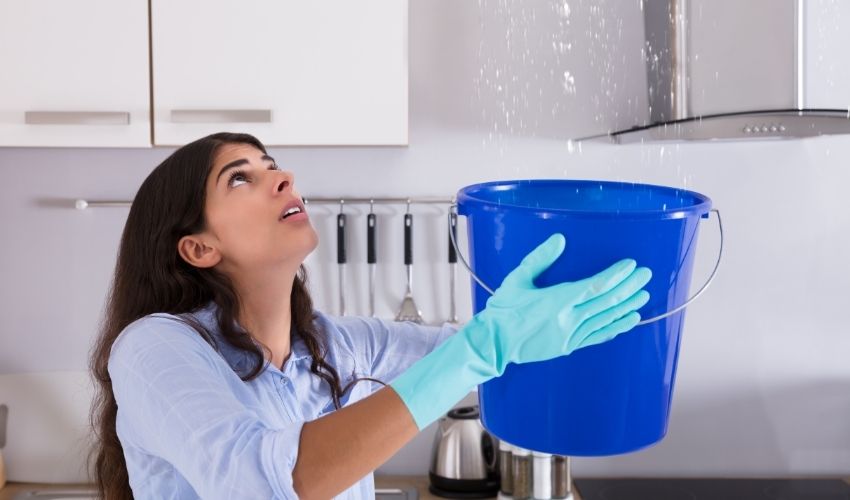
Fixing a Leaking Roof Before Winter
A leaking roof may not seem like a big problem during a long, dry summer, but as winter approaches, it is critical to make the necessary repairs. Fixing a leaking roof before winter can keep the costs minimal and ensure the roof is ready to handle the snow and ice of the winter months.
Problems With Winter Roof Leaks
Putting off leaky roof repairs until winter can make them dangerous, even impossible, to fix. It can be much harder to find a leak when the roof is covered in snow and ice, and if moisture settles into the leak and freezes, the ice will expand and create more damage. This can make the leak monumentally worse when a large snow buildup melts and spring rains begin.
Roofs can be challenging to repair in winter. Not only will snow and ice make the work conditions far more hazardous, but roofing materials may not be as versatile in winter. Asphalt shingles, for example, can become brittle and break more easily in extreme cold, and they rely on the sun’s heat to properly bond together for a leak-proof roof. Similarly, coating compounds may not be able to adhere well to a roof that is cold or wet.
Even if repairs are possible in the winter, the expense may be higher because of insurance costs or extra equipment associated with trickier work settings. If the roof needs to be cleared of snow and ice before repairs begin, that extra time will also add extra costs to the bill. Ultimately, it is best to fix a leaking roof long before winter.
Tips for Fixing a Leaking Roof
Some minor roof leaks are easy for homeowners to repair, and doing it yourself can be a great cost savings as you prep your home for winter.
- Find the Exact Leak Water will run down from its entry point, but will also run sideways along beams and other supports. Before attempting repairs, it is necessary to pinpoint where the leak originates. Check for obvious breaks in the roof, as well as broken or cracked seals or joints. Mold and water stains can help indicate where the leak originated. If necessary, use a hose to simulate rainfall while checking for water penetration.
- Fix Roof Boots Boots around vents, skylights, and plumbing pressure outlets may loosen over time and their seals can crack, creating leaks. Check for rotted rubber and broken seams, and make repairs as necessary to eliminate these leaks.
- Prevent Ice Dams Ice buildup, particularly near gutters or overhangs, can lead to water backups and intermittent leaks. Taking steps to prevent ice dams such as installing heating cables or ice shields, can minimize this risk, and gutters should be thoroughly cleaned out before winter as well.
- Repair Soffit Any soffit damage could create roof leaks as well as damage the walls and foundation of the home. This is especially true when the water may back up and leak near overhangs where the soffit is damaged.
- Repair Flashing Step flashing where walls intersect the roof can corrode and allow leaks to form. This can also be a problem around a chimney. The damaged flashing should be replaced and well-caulked to seal the leaks.
- Patch Small Holes Water can leak through a roof even through the tiniest holes. Small holes from where an old antenna or satellite dish may have been removed should be repaired with flashing inserted underneath the existing shingle, or the shingle should be replaced to seal the gaps.
- Check Gutter Flow If gutters aren’t aligned properly or downspouts aren’t securely attached, backflow can lead to a leaking roof. Check that gutters are adequate for the roof size, and that there are no clogs or other problems that could create leaks.
- Trim Tree Branches Large tree branches that overhang the roof should be removed to prevent the possibility of a fallen branch causing major roof damage. Even small branches that continually rub the roof, however, could cause shingles to shift or create small breaks that could leak, so it is best to trim the branches well away from the roof’s surface.
- Inspect the Roof Annually The roof should be checked at least once a year for any signs of problems such as curling, loose, or misaligned shingles, cracks, holes, warping, or other damage. Additional inspections may be necessary after severe weather such as a tropical storm or hurricane, or if the roof has any impact from fallen branches, even if there may not be obvious, immediate damage.
Know When to Call the Professionals
While many small roof repairs are easy for homeowners, larger, more extensive repairs are best left to professionals. If there is catastrophic damage – such as from severe winds or large branches – it is always best to hire licensed, experienced roofers to complete the repairs. If the roof is already older and may have multiple problems, a professional can more easily gauge the overall work to be done and ascertain whether it would be more effective to do a complete reroofing instead of patchwork repairs. Finally, homeowners should always consider whether they have the handyman skills to make repairs effectively, as well as whether they are in the physical shape to be working on a sloped roof safely. If there are any concerns, it is better to leave the work to the professionals.
Fixing a leaking roof before winter may not seem to be a high priority, but taking care of small leaks before they become larger deluges can not only make the repairs easier, but will be far more cost effective and faster to complete well before winter arrives.
